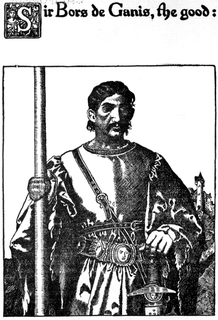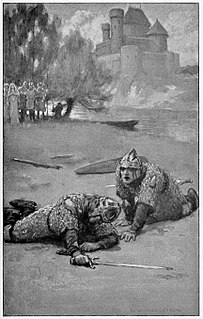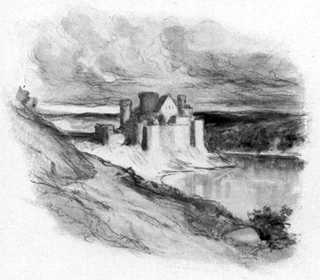
The Holy Grail is a treasure that serves as an important motif in Arthurian literature. Various traditions describe the Holy Grail as a cup, dish, or stone with miraculous powers: providing eternal youth, or sustenance in infinite abundance, often in the custody of the Fisher King. By analogy, any elusive object or goal of great significance may be perceived as a holy grail by those seeking it.

Idylls of the King, published between 1859 and 1885, is a cycle of twelve narrative poems by the English poet Alfred, Lord Tennyson which retells the legend of King Arthur, his knights, his love for Guinevere and her tragic betrayal of him, and the rise and fall of Arthur's kingdom.

Lancelot du Lac, also written as Launcelot and other variants, is a character in some versions of Arthurian legend, where he is typically depicted as King Arthur's close companion and one of the greatest Knights of the Round Table. In the French-inspired Arthurian chivalric romance tradition, Lancelot is the orphaned son of King Ban of the lost kingdom of Benwick, raised in the fairy realm by the Lady of the Lake. A hero of many battles, quests and tournaments, and famed as a nearly unrivalled swordsman and jouster, Lancelot becomes the lord of the castle Joyous Gard and personal champion of Arthur's wife Queen Guinevere. But when his adulterous affair with Guinevere is discovered, it causes a civil war that is exploited by Mordred to end Arthur's kingdom.

Sir Galahad, sometimes referred to as Galeas or Galath, among other versions of his name, is a knight of King Arthur's Round Table and one of the three achievers of the Holy Grail in Arthurian legend. He is the illegitimate son of Sir Lancelot and Elaine of Corbenic and is renowned for his gallantry and purity as the most perfect of all knights. Emerging quite late in the medieval Arthurian tradition, Sir Galahad first appears in the Lancelot–Grail cycle, and his story is taken up in later works, such as the Post-Vulgate Cycle, and Sir Thomas Malory's Le Morte d'Arthur.

The Knights of the Round Table are the knights of the fellowship of King Arthur in the literary cycle of the Matter of Britain. First appearing in literature in the mid-12th century, the Knights are an order dedicated to ensuring the peace of Arthur's kingdom following an early warring period, entrusted in later years to undergo a mystical quest for the Holy Grail. The Round Table at which they meet is a symbol of the equality of its members, who range from sovereign royals to minor nobles.
Le Morte d'Arthur is a 15th-century Middle English prose reworking by Sir Thomas Malory of tales about the legendary King Arthur, Guinevere, Lancelot, Merlin and the Knights of the Round Table, along with their respective folklore. In order to tell a "complete" story of Arthur from his conception to his death, Malory compiled, rearranged, interpreted and modified material from various French and English sources. Today, this is one of the best-known works of Arthurian literature. Many authors since the 19th-century revival of the legend have used Malory as their principal source.

Percival, alternatively called Peredur, was one of King Arthur's legendary Knights of the Round Table. First mentioned by the French author Chrétien de Troyes in the tale Perceval, the Story of the Grail, he is best known for being the original hero in the quest for the Grail, before being replaced in later English and French literature by Galahad.
Percival's sister is a role of two similar but distinct characters in the Holy Grail stories within the Arthurian legend featuring the Grail hero Percival (Perceval). The first of them is named Dindrane, the second is usually unnamed and is known today as the Grail heroine.
Elaine is a name shared by several different female characters in Arthurian legend.

In Arthurian legend, the Fisher King, also known as the Wounded King or Maimed King, is the last in a long bloodline charged with keeping the Holy Grail. Versions of the original story vary widely, but he is always wounded in the legs or groin and incapable of standing. All he is able to do is fish in a small boat on the river near his castle, Corbenic, and wait for some noble who might be able to heal him by asking a certain question. In later versions, knights travel from many lands to try to heal the Fisher King, but only the chosen can accomplish the feat. This is achieved by Percival alone in the earlier stories; he is joined by Galahad and Bors in the later ones.

Bors is the name of two knights in Arthurian legend, an elder and a younger. The two first appear in the 13th-century Lancelot-Grail romance prose cycle. Bors the Elder is the King of Gaunnes (Gannes/Gaunes/Ganis) during the early period of King Arthur's reign, and is the brother of King Ban of Benoic and the father of Bors the Younger and Lionel. His son Bors the Younger later becomes one of the best Knights of the Round Table and participates in the achievement of the Holy Grail.

In Arthurian legend, the Siege Perilous is a vacant seat at the Round Table reserved by Merlin for the knight who would one day be successful in the quest for the Holy Grail. The English word "siege" originally meant "seat" or "throne" coming from the Old French sege ; the modern military sense of a prolonged assault comes from the conception of an army "sitting down" before a fortress.

The Questing Beast, or the Beast Glatisant, is a cross-animal monster appearing in many medieval texts of Arthurian legend and modern works inspired by them. In the French prose cycles, and consequently in the quasi-canon of Le Morte d'Arthur, the hunt for the Beast is the subject of quests futilely undertaken by King Pellinore and his family and finally achieved by Sir Palamedes and his companions.

Elaine of Astolat, also known as Elayne of Ascolat and other variants of the name, is a figure in Arthurian legend. She is a lady from the castle of Astolat who dies of her unrequited love for Sir Lancelot. Well-known versions of her story appear in Sir Thomas Malory's 1485 book Le Morte d'Arthur, Alfred, Lord Tennyson's mid-19th-century Idylls of the King, and Tennyson's poem "The Lady of Shalott". She should not be confused with Elaine of Corbenic, the mother of Galahad by Lancelot.

Sir Balin le Savage, also known as the Knight with the Two Swords, is a character in the Arthurian legend. Like Sir Galahad, Sir Balin is a late addition to the medieval Arthurian world. His story, as told by Thomas Malory in Le Morte d'Arthur, is based upon that told in the continuation of the second book of the Post-Vulgate cycle of legend, the Suite du Merlin.

Corbenic is the name of the Grail castle, the edifice housing the Holy Grail in Arthurian legend. It is a magical domain of the Grail keeper, often known as the Fisher King. The castle's descriptions vary greatly in different sources, and it first appears by that name in the Lancelot-Grail cycle where it is also the birthplace of Galahad.

"The Day-Dream" is a poem written by Alfred Tennyson that was published in 1842. It was an expanded version of his 1830 poem "The Sleeping Beauty". It was further altered in 1848 for a dramatic performance for a private gathering with Tennyson starring as the Prince. The Day-Dream discusses the nature of sleeping and of dreaming, especially in relation to individuals that would want to escape from reality. The poem also compares the act of poetry with dreaming and asserts that the two are the same.

Lancelot is a text adventure game by Level 9 released in 1988. It features static graphics on some platforms. The plot focuses on Lancelot's quest to find the Holy Grail.

"Break, Break, Break" is a poem by Alfred, Lord Tennyson written during early 1835 and published in 1842. The poem is an elegy that describes Tennyson's feelings of loss after Arthur Henry Hallam died and his feelings of isolation while at Mablethorpe, Lincolnshire.

The Holy Grail or San Graal tapestries are a set of six tapestries depicting scenes from the legend of King Arthur and the quest for the Holy Grail. The tapestries were commissioned from Morris & Co. by William Knox D'Arcy in 1890 for his dining room at Stanmore Hall, outside London. Additional versions of the tapestries with minor variations were woven on commission by Morris & Co. over the next decade.
















